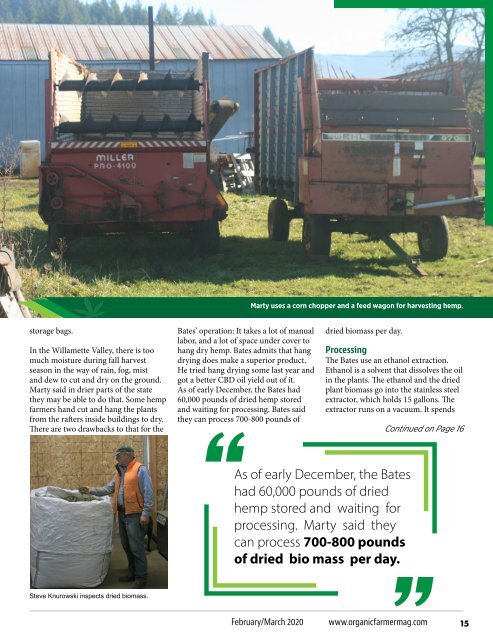You also want an ePaper? Increase the reach of your titles
YUMPU automatically turns print PDFs into web optimized ePapers that Google loves.
Marty uses a corn chopper and a feed wagon for harvesting hemp.<br />
storage bags.<br />
In the Willamette Valley, there is too<br />
much moisture during fall harvest<br />
season in the way of rain, fog, mist<br />
and dew to cut and dry on the ground.<br />
Marty said in drier parts of the state<br />
they may be able to do that. Some hemp<br />
farmers hand cut and hang the plants<br />
from the rafters inside buildings to dry.<br />
There are two drawbacks to that for the<br />
Bates’ operation: It takes a lot of manual<br />
labor, and a lot of space under cover to<br />
hang dry hemp. Bates admits that hang<br />
drying does make a superior product.<br />
He tried hang drying some last year and<br />
got a better CBD oil yield out of it.<br />
As of early December, the Bates had<br />
60,000 pounds of dried hemp stored<br />
and waiting for processing. Bates said<br />
they can process 700-800 pounds of<br />
dried biomass per day.<br />
Processing<br />
The Bates use an ethanol extraction.<br />
Ethanol is a solvent that dissolves the oil<br />
in the plants. The ethanol and the dried<br />
plant biomass go into the stainless steel<br />
extractor, which holds 15 gallons. The<br />
extractor runs on a vacuum. It spends<br />
Continued on Page 16<br />
Steve Knurowski inspects dried biomass.<br />
<strong>February</strong>/<strong>March</strong> <strong>2020</strong><br />
www.organicfarmermag.com<br />
15


















